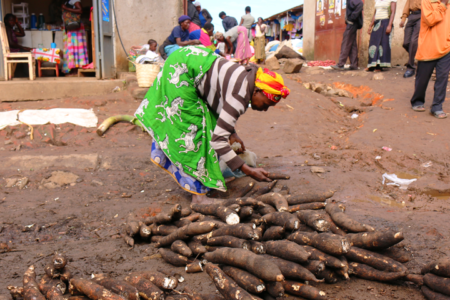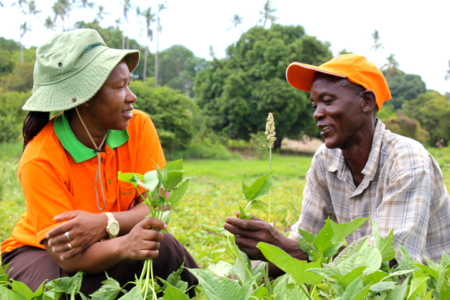Studies in three Africa countries validate the value of seed system tools

Seed systems are essential for getting new crop varieties to farmers and, in the case of banana, cassava, potato, sweetpotato and yam, they can improve the yields of established varieties. This is because farmers plant vegetatively propagated seed (e.g., tubers, vines, or roots) for those crops, and that planting material is frequently infected with pests or diseases that can significantly reduce yields. This constitutes a persistent threat to the incomes and food security of the hundreds of millions of smallholder farmers in Africa, Asia and Latin America who depend on root, tuber and banana (RT&B) crops for nourishment and livelihoods.
Recent research in three African countries using tools developed to better understand and improve farmer access to and use of improved varieties and quality seed points the way toward holistic solutions to the dilemma of diseases and pests spread by seed, and opportunities to improve production of RT&B crops by resource-poor farming families. Teams of young men and women researchers and development professionals who work with RT&B crops undertook research on characterizing seed systems and diagnosing bottlenecks in Ethiopia, Tanzania and Uganda in recent months and presented their findings in a three-day virtual workshop in late October.
The workshop was the latest in a series of webinars to promote and inform people about the Toolbox for Working with Root, Tuber and Banana Seed Systems, a collection of 11 tools to study and improve RT&B seed systems. They were developed by a multi-disciplinary team of more than 50 scientists and practitioners in 17 countries who work with the CGIAR Research Program on Roots, Tubers and Bananas (RTB) and they constitute one of RTB’s “golden eggs” – knowledge assets developed through the research program’s varied collaborations that are available for free online.
Three countries, four crops

In Tanzania, a team of 10 researchers used the seed tracing tool to study sweetpotato planting material sourcing by farmers in the Geita Region. Based on interviews with 94 women and 64 men in 10 villages, they found that while some purchase planting material from seed producers, the majority of farmers plant vines taken from their own fields, or from neighbors or relatives in their area, indicating the importance of decentralized seed distribution approaches. However, because sweetpotato plants in farmers’ fields tend to be infected with yield-apping viruses, sourcing vines from their own field or friends and neighbors usually results in low yields.
The team of researchers in Ethiopia encountered a comparable situation with potato. They conducted a multi-stakeholder framework analysis of potato seed systems in Oromia – the country’s top potato producing state – and found unmet farmer demand for quality seed. They identified insufficient production of virus-free starter material for seed potato multiplication, a shortage of government extension officers with potato expertise, and a lack of private seed companies as factors limiting farmer access to healthy seed potatoes.
Taye Tadesse, Crop Director at the Ethiopian Institute of Agricultural Research, acknowledged those shortcomings. “Access to sufficient quality and quantity of seed of improved varieties is the big challenge for increasing food production in our country,” he says.
According to Ian Barker, director of the International Potato Center’s Global Potato Agri-Food Systems Program, “The Ethiopia study demonstrates the importance of addressing these kinds of bottlenecks in seed systems.”
Barker is also the lead of the SeEdQUAL initiative – a cross-crop CGIAR initiative that aims to improve the dissemination of new varieties and enhance crop yields though more dynamic, inclusive and sustainable seed systems. He explains that this includes a stage-gated approach that extends from breeding through seed delivery, with an important nexus between the late stage of breeding and seed production.
“I can see readily where many of these tools fit into the needs of this initiative,” Barker says.
Paying attention to gender
In Uganda, where the top staples are banana and cassava, and an estimated half of their potential production is lost to disease and climatic stress, researchers used two of the 11 tools: the four square method – to determine the popularity of different varieties and the scale they’re grown on – and means end chain analysis, to determine farmer preferred crop characteristics and motivations.

They held focus groups with 41 men and 33 women farmers and conducted individual interviews with 50 of them and found significant differences between the choices and strategies of men and women, which are largely determined by how much land they have, or have access to. Men farmers have more land than women, and they grow fewer varieties – often one or commercially demanded varieties of banana or cassava for sale or transformation. Men tend to grow high-yielding, bitter cassava varieties that are processed for starch and banana varieties that are fermented to make beer or other alcoholic beverages. Women farmers, who have smaller plots, depend on them for food production. They thus plant a greater diversity of crops and varieties, including cassava and banana varieties apt for intercropping and fresh consumption, to meet their dietary needs and reduce their risk of hunger.
Nicoline de Haan, Director of the CGIAR Gender Platform, commended the researchers and tools’ designers, saying: “The great thing is that these tools enable researchers to take gender differences into account.”
According to de Haan: “Inclusion isn’t always intentional. If it isn’t planned, it will not happen.”
“The vital question is: How do we better design seed systems for equitable outcomes?” she says, explaining that this requires understanding both women’s strategic needs and structural issues such as access to land.
“We need more tools like these and we need more evidence like this,” de Haan adds.
Members of the research teams are submitting articles on their studies to scientific journals for publication, and they will be supported in the development and submission of project proposals to turn their findings into actions to address seed system bottlenecks.
Other researchers or practitioners who want to better understand or improve seed systems can visit the Tools for Seed Systems website.
